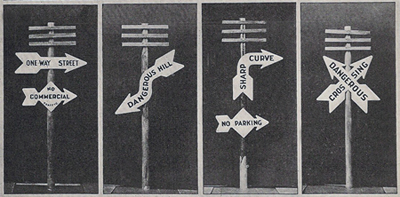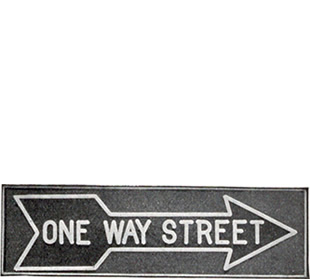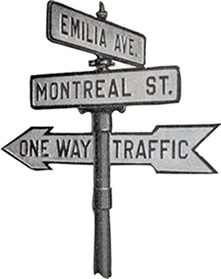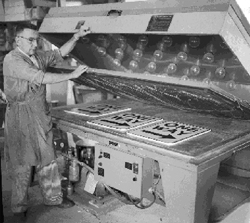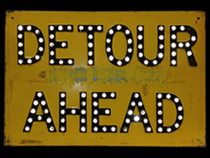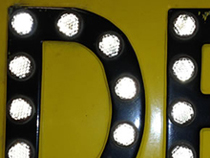The American automobile industry emerged at the turn of the 20th century, and one-way streets became popular a few decades later, as the network of roads expanded. A one-way street confines vehicles to one specified direction, in case of overly narrow or busy streets. The first one-way street is believed to have been in Lima, Peru. As one-way streets became common in the United States, the need for one-way street signs arose. Since then,the one-way traffic sign has evolved from a flimsy arrow-shaped piece of wood to a reflective aluminum rectangle, while still retaining its original color scheme and essential design.
The original American one-way sign was a black and white die-cut sign in the shape of an arrow. In 1925, the Traffic Committee of the International Police Conference in New York was the first to propose a standardization of traffic signs and one-way signs.
Author's collection: Models recommended by the Traffic Committee of the International Police Conference
It seems that, for a while, sign manufacturing companies took the Traffic Committee’s suggestions to heart. Some of the first Depression era one-way signs from Minnesota’s Lyle Culvert Company (below left) and the Lebanon, New Hampshire-based Niles Machine Company (below right) were designed according to the committee’s specifications.
Author's collection: Niles Machine Company
Author's collection: Lyle Signs
For a few decades, the arrow-shaped, one-way sign hung in many streets, and even became a cultural symbol of traffic regulation. In the 1940’s arrow-shaped one-way signs hung in every borough of New York, and became iconic.
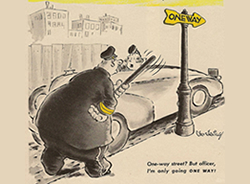
Comic showing 1940s one-way sign.
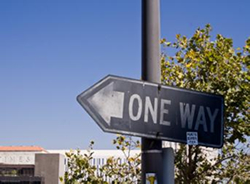
A one-way sign in downtown LA that is believed to have been erected in the 1960’s or the 1970’s (image courtesy of Eric Richardson of
blogdowntown.com/).
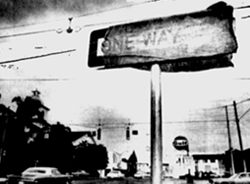
A white and black one-way sign ready to be unveiled in St. Petersburg, Florida in February of 1977 (image courtesy of St. Petersburg Times Archives).
Eventually, the arrow-shaped sign was phased out in favor of a simpler design that could be more easily and efficiently mass-manufactured. In the 1950’s, sign manufacturers began to revert to a simpler, rectangular design.The simple black and white sign—longer vertically than horizontally—was installed across the nation, from New York to California.
Seattle engineers pressing similar one-way signs in 1958 (image courtesy of Seattle Municipal Archives).
A worker installs new rectangular one-way signs in Toledo, Ohio in 1951 (image courtesy of Toledo Blade Archives).
And by the time Reagan took office, American one-way traffic signs had become completely standardized to reflect the design that peppers today’s roads.
A worker installs a one-way sign in Lewiston, Maine in 1987 (image courtesy of The Lewiston Journal Archives).
But getting everyone to follow the sign directions is a task easier said than done, like for these geese. (Image courtesy of Lakeland Ledger).
There is also the issue of visibility. After all, how can you expect drivers to obey a sign if they can’t see it? This becomes an especially large problem at night. At first, sign engineers solved this problem by outfitting their signs with reflective buttons.
Detour Ahead sign with reflective buttons.
Close-up of reflective buttons.
Recently, reflective buttons have disappeared; the new generation of
one-way signs use metallized glass beads or increasing microscopic plastic prisms to in order to be fully reflective and maximize visibility in all light conditions. Made of durable aluminum and printed in high definition, one-way street signs can appear in a variety of designs, but the standardized design remains the most common—a fixture at street intersections in all 50 states.
The one-way sign has come a long way from its original incarnation, but it has retained its black and white template. The arrow symbol has remained integral to the design. The standards state, "they shall be used to indicate streets or roadways upon which vehicular traffic is allowed to travel in one direction only."
